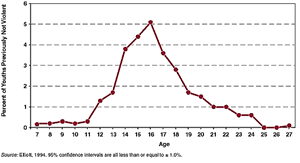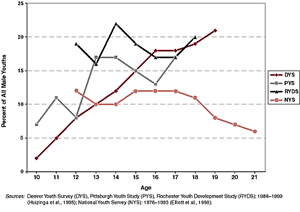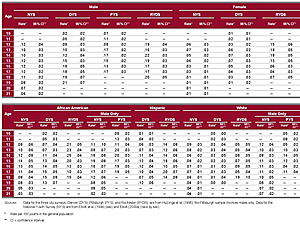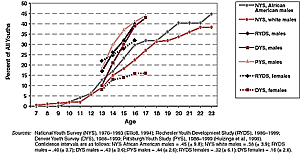 |
|||||||||
Chapter 3
The Developmental Dynamics of Youth Violence
Most violence begins in the second decade of life. This chapter looks closely at childhood and adolescence as critical periods of development to trace how violence unfolds—its onset, duration, and continuity into adulthood. It also examines violence in relation to other risky behaviors that emerge in adolescence.
The dynamics of youth violence are best understood from a developmental perspective, which recognizes that patterns of behavior change over the life course. Adolescence is a time of tumultuous change and vulnerability, which can include an increase in the frequency and means of expression of violence and other risky behaviors. Understanding when and under what circumstances violent behavior typically occurs helps researchers craft interventions that target those critical points in development.
Our understanding of developmental patterns depends in large part on longitudinal studies, which track the same group of individuals over long periods of time, sometimes a decade or more. Four major longitudinal studies are described in this chapter. They add new dimensions to the surveillance statistics presented in Chapter 2, and they provide essential background for Chapter 4, which deals with why young people become involved in violence.
EARLY- AND LATE-ONSET TRAJECTORIES
Longitudinal research has detected two prominent developmental trajectories for the emergence of youth violence, one characterized by an early onset of violence and one by a late onset. Children who commit their first serious violent act before puberty are in the early-onset group, whereas youths who do not become violent until adolesence are in the late-onset group. While other developmental trajectories have been identified (D'Unger et al., 1998; Nagin & Tremblay, 1999), this report focuses on the early- and late-onset trajectories because they are recognized by most researchers, they debunk the myth that all serious violent offenders can be identified in early childhood, and they have strikingly different implications for prevention.
In the early-onset trajectory, problem behavior that begins in early childhood gradually escalates to more violent behavior, culminating in serious violence before adolescence. A child's first serious violent act may have been officially recorded, or it may have been reported by the child to researchers in a confidential survey. The early-onset group, in contrast to the late-onset group, is characterized by higher rates of offending and more serious offenses in adolescence, as well as by greater persistence of violence from adolescence into adulthood (reviewed in Stattin & Magnusson, 1996, and Tolan & Gorman-Smith, 1998). The National Youth Survey shows that nearly 13 percent of male adolescents in the early-onset trajectory engaged in violence for two or more years, compared to only 2.5 percent in the late-onset trajectory (Tolan & Gorman-Smith, 1998).
Between 20 and 45 percent of boys who are serious violent offenders by age 16 or 17 initiated their violence in childhood (D'Unger et al., 1998; Elliott et al., 1986; Huizinga et al., 1995; Nagin & Tremblay, 1999; Patterson & Yoerger, 1997; Stattin & Magnusson, 1996). A higher percentage of girls who were serious violent offenders by age 16 or 17 (45 to 69 percent) were violent in childhood (Elliott et al., 1986; Huizinga et al., 1995). This means that most violent youths1 begin their violent behavior during adolescence. However, the youths who commit most of the violent acts, who commit the most serious violent acts, and who continue their violent behavior beyond adolescence begin during childhood (Loeber et al., 1998; Moffitt, 1993; Tolan, 1987; Tolan & Gorman-Smith, 1998).
The greater prevalence of late-onset youth violence refutes the myth that all serious violent offenders can be identified in early childhood. In fact, the majority of young people who become violent show little or no evidence of childhood behavioral disorders, high levels of aggression, or problem behaviors—all predictors of later violence.
The implications of these findings for prevention are clear: Programs are needed to address both early- and late-onset violence. Targeting prevention programs solely to younger children with problem behavior misses over half of the children who will eventually become serious violent offenders, although universal prevention programs in childhood may be effective in preventing late-onset violence (see Chapters 4 and 6).
ONSET AND PREVALENCE OF SERIOUS VIOLENCE
Much of what is known about the onset, prevalence, and other characteristics of serious violence during the adolescent years comes from four important longitudinal surveys. The only nationally representative one is the National Youth Survey (NYS), an ongoing study of 1,725 youths age 11 to 17 in 1976, when the survey began (Elliott, 1994). These youths have been tracked by researchers for more than two decades and through nine waves, or points at which they were interviewed and/or their official records were sought to corroborate self-reported violence.2
The other three longitudinal studies cited here are city surveys sponsored by the U.S. Office of Juvenile Justice and Delinquency Prevention and the National Institutes of Health (Huizinga et al., 1995; Thornberry et al., 1995).3 Beginning in 1988, three teams of researchers began to interview 4,500 youths age 7 to 15 in three cities—Denver, Pittsburgh, and Rochester (New York). These youths were monitored at different points from 1988 to 1994. Each sample disproportionately represents youths at high risk of delinquency to ensure that it is large enough to draw valid conclusions about delinquency and violence, but each also uses weighting procedures to yield locally representative estimates. The estimates presented here are based on weighted data.
These four surveys define serious violence as aggravated assault, robbery, gang fights, or rape; an individual is labeled a serious violent offender if he or she reports committing any one or more of these offenses.4 Gang fights are included because follow-up information on these fights reveals that most of them involve injury serious enough to require medical attention (Elliott, 1994).
Only the NYS reports the hazard rate for serious violence during the first two decades of life.5 The hazard rate is the proportion of persons who initiate serious violence at a given age. Serious violence begins mostly between the ages of 12 and 20 (Figure 3-1). In fact, 85 percent of people who become involved in serious violence by age 27 report that their first act occurred between age 12 and 20. The onset of serious violence is negligible after age 23 and before age 10 (only 0.2 percent of arrests for serious violent crime in 1997 involved a child under age 10 [Maguire & Pastore, 1999]).
Figure 3-1. Hazard rate for initiating serious violence, by age, National Youth Survey
The peak age of onset is 16, when about 5 percent of male adolescents report their first act of serious violence. The age of onset peaks somewhat later for white males (age 18) than for African American males (age 15). The hazard rate at the peak age also varies somewhat by race/ethnicity. It is lower for white males (5 percent) than for African American males (8 percent) (Elliott, 2000a). A similar finding is reported in the Pittsburgh Youth Survey (Huizinga et al., 1995).6 No comparable hazard rates have been published for female youths, but other studies have found that they are generally lower.7
Age-specific prevalence—that is, the proportion of youths at any given age who report having committed at least one serious violent act—is also greatest in the second decade of life. The NYS and the three city surveys find that, broadly speaking, age-specific prevalence among male youths ranges from about 8 to 20 percent between the ages of 12 and 20 (Figure 3-2). Among females, it ranges from 1 to 18 percent (Table 3-1). There is some variability across surveys, however. In general, the NYS has lower rates than the three city surveys, reflecting the difference between a national sample and local samples drawn from urban areas. The differences may also reflect the timing of the studies. NYS estimates cover the years 1976 to 1986, whereas the three city surveys cover the years 1986 or 1988 to 1994, the peak years of the violence epidemic (see Chapter 2). Nevertheless, the estimates for age 17 across these longitudinal surveys are in the same range as those for high school seniors in the Monitoring the Future survey (see Chapter 2).
Figure 3-2. Prevalence of serious violence among male youths, by age: four longitudinal surveys
Another key difference between the national and city surveys is the maturation effect, or the age at which serious violence begins to decline sharply during the transition to adulthood. The NYS shows a decline in age-specific prevalence starting in the late teen years and a steep drop-off by age 20. In contrast, the city surveys, which were begun more recently, do not show a decline in the late teen years (Huizinga et al., 1995), and they have not yet published data on prevalence in early adulthood. Therefore, it is too soon to tell whether or at what age more recent groups of youths will mature out of violence. It is possible that young people are staying violent longer.
Some important differences in age-specific prevalence by sex have emerged from the data (Table 3-1). Female adolescents have lower rates of serious violence throughout the second decade. For the NYS and Denver surveys, rates at age 12 are about twice as high for boys as for girls. Between age 12 and 15 in Rochester, the rates are fairly similar. For all studies, the rates for females at age 17 are about one-quarter the rates for males. In addition, the peak age of serious violent offending occurs a few years earlier among females, and their maturation out of serious violence is both earlier and steeper than males'.
Age-specific prevalence also varies by race/ethnicity (Table 3-1). The NYS finds a significant racial gap between ages 14 and 17, when rates for African American youths are 36 to 50 percent higher than those for white youths. The city surveys show an even wider gap between African American and white youths (Huizinga et al., 1995). Rates among Hispanic youths, reported only for Denver and Rochester, are similar to or lower than those reported by African American youths in these cities. The prevalence reported by Hispanic youths ranges from 6 to 12 percent in Denver and about 10 to 20 percent in Rochester. Possible reasons for developmental differences by sex, race, and ethnicity are discussed in Chapter 4. None of these comparisons takes into account the effects of poverty, education, housing, or other environmental conditions.
Table 3-1. Prevalence of serious violence by age, sex, and race/ethnicity: four longitudinal surveys
CUMULATIVE PREVALENCE
Cumulative prevalence refers to the proportion of youths at any particular age who have ever committed a serious violent offense.8 As a measure of violence, it tends to equalize rather than magnify differences across populations because it counts youths only once, regardless of when or how often they engaged in violent acts.
The most striking feature of the cumulative prevalence is its sheer magnitude: About 30 to 40 percent of male and 16 to 32 percent of female youths have committed a serious violent offense by age 17 (Figure 3-3). Although these rates are only slightly higher than those found in international studies, the represent a more serious set of offenses (Junger-Tas et al., 1994).
Figure 3-3. Cumulative prevalence of serious violence, by age, sex, and race: four longitudinal surveys
The cumulative prevalence of youth violence is generally consistent across the four surveys. For male youths, the NYS shows it rising to about 40 percent and then leveling off beyond age 22. In the city surveys, it reaches more than 40 percent of male and 32 percent of female youths by age 17. Not only is the rise in cumulative prevalence by age 17 steeper in the city surveys, the magnitude is substantially higher.
These differences between a nationally representative sample and city samples are to be expected. The timing of the surveys may also explain some of the differences. For example, 17-year-olds in the NYS were interviewed at some point between 1976 and 1982, whereas 17-year-olds in the city surveys were interviewed at some point between 1988 and 1994, the era during which the self-reported prevalence of serious youth violence increased somewhat (see Chapter 2).
There is a pronounced difference in cumulative prevalence by sex. Among 17-year-olds, the Denver survey found a cumulative prevalence of 16 percent for female youths and 43 percent for male youths, whereas the Rochester survey showed 32 percent and 40 percent, respectively. Data on cumulative prevalence for females are not available in the Pittsburgh survey or the NYS.9
On the other hand, there are few differences in cumulative prevalence by race over the teen years, according to the NYS. By age 23, white males had a cumulative prevalence of 38 percent and African American males had a cumulative prevalence of 45 percent, a difference that is not statistically significant (Figure 3-3).
| 1 | A higher proportion of serious violent offenders are male (Chapter 2). |
| 2 | Several other national longitudinal youth surveys are in progress, but none of them has tracked a sample long enough to provide descriptions of developmental trajectories in adolescence. |
| 3 | Confidence intervals for all four surveys are based on simple binomial distributions and do not reflect the full sampling designs of these studies. |
| 4 | In each survey, follow-up questions were asked to determine the seriousness and appropriateness of the reported event. Reports of nonserious events were not included. This adjustment could not be made for the first 3 years of the NYS, so for those years at least two serious violent offenses were required for a youth to be classified as a serious violent offender. |
| 5 | The rates for age 10 and under are based entirely upon retrospective reports and may not be as reliable as those for age 11 and older. |
| 6 | The actual hazard rates are not presented, but the investigators note that the rates were higher for African Americans between the ages of 12 and 16 (Huizinga et al., 1995). |
| 7 | Using a slightly different definition of serious violent offender (three or more serious violent offenses), the hazard rate for females peaked at age 14 (1.5 percent ± 1.0 percent) and dropped by age 17 (0.6 percent ± 0.5 percent) (Elliott et al., 1986). |
| 8 | Cumulative prevalence is also known as lifetime prevalence or ever-prevalence to a given age. |
| 9 | The NYS reports an 11 percent cumulative prevalence at age 21 among females who are chronic (committing three or more offenses per year) serious violent offenders. |



